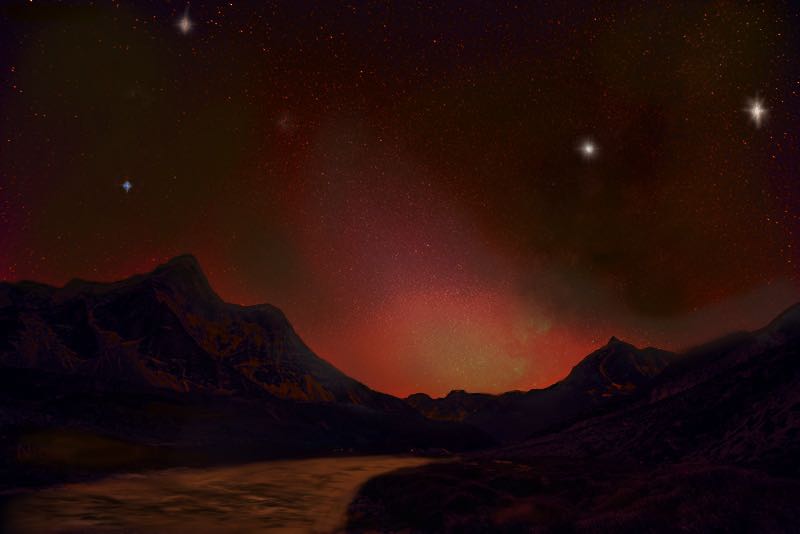Zodiacal dust emission found in three potentially habitable planet worlds from the Kepler mission
After a sunset on a clear day, a faint, diffuse, and roughly triangular white glow appears in the night sky extending upwards from the Sun. This white glow is scattered light from the zodiacal dust cloud which is formed by comet dust deposits and asteroid collisions in our solar system’s asteroid belt. Does this kind of dust exist in extrasolar habitable worlds? An international team led by Professor Jian Ge at Shanghai Astronomical Observatory, Chinese Academy of Sciences, has provided an answer to this question.
His team, consisting of researchers from the US and China, recently discovered zodiacal dust thermal emission from three well-known potentially habitable worlds, namely Kepler-69c, Kepler-1229b, and Kepler-395c – that were all detected by the NASA Kepler mission from 2000 to 2013.
“These discoveries became possible thanks to the big data age,” says Professor Ge. “Our team started from wondering if zodiacal-like dust may exist in extrasolar habitable worlds, then gathered online data from many space missions and ground-based telescopes and conducted careful analyses to finally make these discoveries.”
“We first collected all currently known habitable planet candidates published by the latest Kepler team, then collected online data from sky surveys such as WISE, 2MASS, Gaia, Spitzer, and PAN-STARRS,” explains high school researcher Amanda Hao. “We were able to identify initial candidates by measuring excessive infrared radiation at the WISE mid-infrared wavelength bands through spectral decomposition.”
Justin Hou, another high school researcher who contributed to the project, says, “Once we had candidates, we obtained high-contrast infrared image data from 2MASS and the UKIRT Infrared Deep Sky Survey to check if our candidate stars had any nearby bright background targets. If they did, we eliminated them as potential candidates.”
“For the remaining candidates, we carefully removed the thermal infrared flux contributions of very faint background sources to the candidate host stars,” explains research assistant Kevin Willis. “We concluded our final detection of zodiacal-cloud-like debris disks surrounding these three habitable worlds after these candidates showed significant remaining thermal infrared emission at 12 microns.”
Larry Ge, another high school researcher, comments, “We measured rotational speeds of these stars and found Kepler-1229 and Kepler-395 are rotating much faster than our sun, indicating that these two stars are much younger than our sun.”
“We also measured dust temperatures to be around 400 degrees Kelvin, which indicates that dust may be located at the region close to these habitable planets. In the solar system, zodiacal dust shows temperatures between 130 to 390 degrees Kelvin.” adds Professor Ge. According to the NASA website, the three habitable planets are Super-Earths, having 2-3 times Earth’s mass. “It is possible that two of these planet systems are young and active and may also contribute to the reshaping of these dust distributions in regions closer to their host star, heating it to higher temperatures.”
Professor Ge, who is leading the Earth 2.0 space mission study in China, comments, “The Kepler mission has revealed great diversity in the extrasolar planetary environments. We hope our future Earth 2.0 space mission will be able to help uncover more secrets of extrasolar planetary environments, especially of habitable Earth-like planets.”

This artist’s impression shows a view of the night sky with zodiacal light shortly after sunset on the surface of the planet Kepler-1229b. Kepler-1229b is a Super-Earth with 2.7 Earth masses and it orbits in the habitable zone around a red star Kepler-1229, where the temperature is suitable for liquid water to exist on its surface. Credit: SHAO/Yue Xu This artist’s impression shows a view of the night sky with zodiacal light shortly after sunset on the surface of the planet Kepler-69c. Kepler-69c is a Super-Earth with 2.1 Earth masses and it orbits outside of the inner edge of the habitable zone around a Sun-like star, Kepler-69. The planet’s atmosphere and surface likely resembles those of Venus. 
Credit: SHAO/Yue Xu
Science Contact:
Jian Ge, Shanghai Astronomical Observatory, jge@shao.ac.cn, 1-352-246-1398
Download attachments: